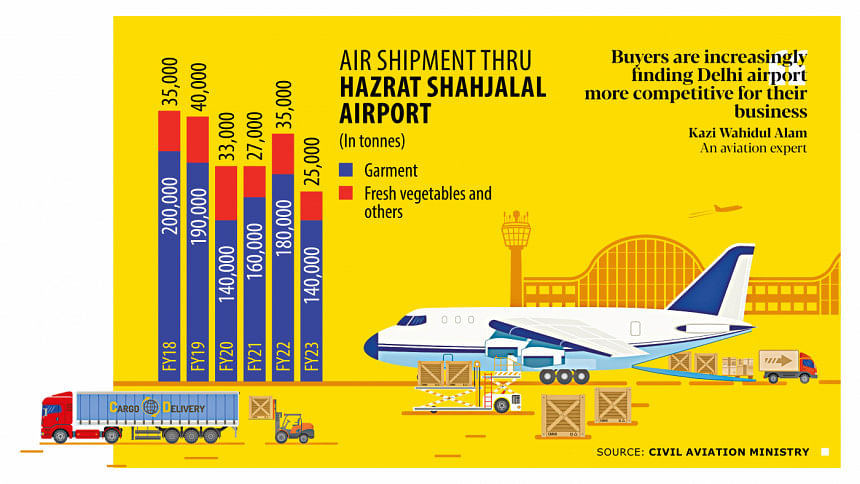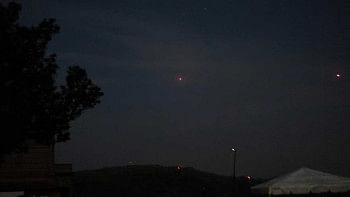Buyers shift to Delhi airport as higher expenses make Dhaka unattractive

International clothing retailers and brands sourcing from Bangladesh prefer the Delhi airport to Hazrat Shahjalal International Airport (HSIA) to carry goods owing to the lower tariff offered by India.
The tariff at the largest airport in Bangladesh is so high that buyers stay competitive even when their goods travel a distance of nearly 1,900 kilometres in trucks from the country to Delhi via Benapole and Petrapole.
For example, it costs $3 to transport one kilogramme of garment items from the HSIA to destinations in Europe. The charge is $1.2 if the goods are sent via Delhi's Indira Gandhi International Airport.
An elevated level of tariffs, value-added tax, and ground handling and service charges at the HSIA are mainly driving users away from Dhaka.
At the airport, a 72 percent surcharge is imposed for ground handling. If the fee is not paid on time, a 60 percent fine is levied.
A total of 1,65,000 tonnes of cargoes were shipped from the HSIA In July-March of the current fiscal year, according to data from the civil aviation and tourism ministry. Of the quantity, 1,34,000 tonnes were garment items and 30,000 tonnes were vegetables, fruits and other items.
In 2022-23, some 1,67,000 tonnes of cargoes were sent abroad via the airport. This included 142,000 tonnes of garment products and 24,000 tonnes of fruits, vegetables, and allied food items.
Kazi Wahidul Alam, an aviation expert, said more than 8,000 tonnes of cargoes, especially those containing garment items, were diverted from the HSIA to Delhi last year because of higher tariffs.
"The volume is higher this year as buyers are increasingly finding Delhi airport more competitive for their business," he said, adding that 50 tonnes of cargoes are redirected from the HSIA to Delhi every day on average.
Owing to the higher charges, local airlines, freight forwarders, courier companies, ground handlers, and many other related sectors are losing business.
At least eight private airlines that tried to do business on the domestic routes of Bangladesh could not become competitive because of escalated high tariffs, Alam said.
Kabir Ahmed, president of the Bangladesh Freight Forwarders Association, described the freight charge at the Dhaka airport as extremely high.
The use of the Delhi airport allows exporters to save 40 US cents to 50 US cents per kg even after carrying goods from Dhaka to the capital of India, he said.
Air shipments have increased after cargo-laden commercial vessels using the traditional route of the Suez Canal of the Red Sea, the main seaway for transportation of goods between Asia and Europe, have come under Houthi attacks since October last year.
The increased arrival of cargoes from Bangladesh has put pressure on the Delhi airport. As a result, India-originated goods can't be shipped on time, exporters in the neighbouring country have alleged.
They have already demanded Delhi impose extra charges on Bangladeshi goods to discourage them from using the airport.
Industry people say any airport can impose extra tariffs if it deems fit. Airlines in Dhaka also increase charges when the flow of cargoes rises. Such a spike is, however, temporary.
SM Mannan Kochi, president of the Bangladesh Garment Manufacturers and Exporters Association, doesn't think exports will be affected if the Delhi airport imposes any additional charges on Bangladeshi goods.
The cost of operation will increase, he, however, admitted.
This is because international buyers usually bear the freight charge since local suppliers send goods under the freight-on-board arrangement.
The cargo village at the HSIA is struggling to meet the rising demand. Currently, it has the capacity to store 400 tonnes of exportable goods whereas daily shipment averages 800 tonnes during normal times and surges to 1,200 tonnes during peak times.
Users have also long complained about thefts of goods from the tiny cargo village, products left unattended, and the deterioration of the quality of items.
Qatar and Etihad used to carry cargoes from the HSIA in dedicated flights even a few years ago. Now, they have either suspended their flights or reduced their capacity.
About 60 percent of all cargoes transported by air from Bangladesh are carried by passenger aircraft, while the remaining by exclusive cargo flights.


 For all latest news, follow The Daily Star's Google News channel.
For all latest news, follow The Daily Star's Google News channel. 



Comments